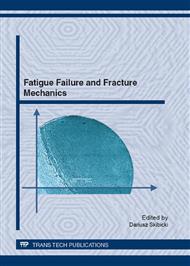[1]
O. Andersen, W. Popp, M. Schaffrabek, D. Stenmetz, H. Stenger, Schaetzen und Testen, Springer Verlag, Berlin, 1976.
Google Scholar
[2]
J.S. Bendat, A.G. Pierdol, Methods of analysis and measurement of random signals, (in Polish), PWN, Warszawa, 1976.
Google Scholar
[3]
L. Gajek, M. Kałuszka, Statistical conclusion validity, (in Polish), WNT, Warszawa, 2000.
Google Scholar
[4]
ASTM standard, Standard Practices for cykle counting in fatigue analysis, ASTM Designation: E 1049-85 (Reapproved 1990).
Google Scholar
[5]
S. Kocańda, J. Szala, Fundamentals of fatigue calculations, (in Polish), PWN, Warszawa, 1997.
Google Scholar
[6]
J. Szala, Programmed fatigue tests of materials and reveted structural components in aviation industry – selected problems, Monographs, 4nd part of monograph: Improvement of fatigue life of rivet connections applied in aviation structures – selected problems, Publishing House of Operation Technology Institute - State Research Institute, Radom, 2010.
Google Scholar
[7]
P. Heuler, H. Klätschke, Generation and use of standardized load spectra and load – time historie, International Journal of Fatigue, 27 (2005).
Google Scholar
[8]
E. Haibach, Betriebsfestigkeit – verfahren und daten zur bauteilberechnung, VDI Verlag, 1989.
Google Scholar
[9]
Atlas of Fatigue Curves, ASM International, The Materials Information Society, Publishing House of Howard E. Boyer, 2003.
Google Scholar
[10]
W.W. Bołotin, Applied statistical methods in mechanics of buildings, Publishing House of Arkady, 1968.
Google Scholar
[11]
R.B. Heywood, Designing Against Fatigue, Chapman Hall, Londyn, 1962.
Google Scholar
[12]
J. Szala, G. Szala, Two-parametric fatigue characteristics formulating problem, Maintenance problems, no. 3 (2001), 287-296.
Google Scholar
[13]
J. Szala, G. Szala, Comparative analysis of two-parametric fatigue characteristics and their experimental verification, Maintenance problems, no. 3 (2001), 297-304.
Google Scholar
[14]
J. Szala, A. Lipski, Conception of description of material fatigue properties in calculations of structural elements (in Polish), Problems of Machines Operation and Maintenance, no. 2 (2005).
Google Scholar
[15]
B. Ligaj, G. Szala, Experimental verification of two-parametric models of fatigue characteristics by using the tests of S355J0 steel as an example, Polish Meritime Research, no.1 (2010), 39-50.
DOI: 10.2478/v10012-010-0004-5
Google Scholar
[16]
B. Ligaj, Experimental and calculational analysis of Steel fatigue life in random conditions of wide range spectra, (in Polish), Monographs, 2nd part of monograph: Two-parametric fatigue characteristics of steel and their experimental verification, Publishing House of Operation Technology Institute - State Research Institute, Radom, 2011.
Google Scholar
[17]
G. Szala, Theoretical and experimental analysis of two-parametric fatigue life characteristicsm of constr, (in Polish), Monographs, 1nd part of monograph: Two-parametric fatigue characteristics of steel and their experimental verification, Publishing House of Operation Technology Institute - State Research Institute, Radom, 2011.
Google Scholar
[18]
I.E. Figle, An empirical wquation relating fatigue limit and mean stress, NASA Technical note TND-3883, Washington, 1967.
Google Scholar
[19]
G. Szala, Stress sensivity coefficient of a material in range of high – cycle fatigue, Maintenance problems, no. 4 (2010), 7-16.
Google Scholar
[20]
G. Szala, B. Ligaj, Evaluation criteria of low- and high-cycle fatigue in fatigue life calculations of constructional elements, Logistyka, no.6 (2009).
Google Scholar
[21]
S. Mroziński, J. Szala, Problem of cyclic hardening or softening in metals under programmed loading, Scientific Problems of Machines Operation and Maintenance, no. 4 (164), vol. 45 (2010), 83-96.
Google Scholar


